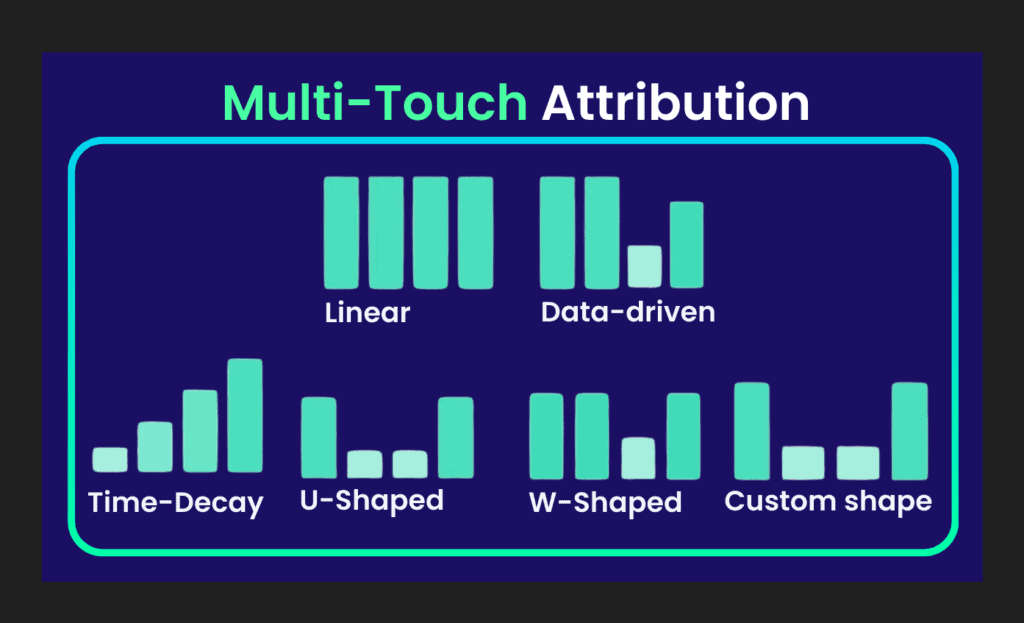In the ever-evolving landscape of digital marketing, understanding the impact of each touchpoint in a customer’s journey is crucial. This is where Multi-Touch Attribution comes into play, offering a nuanced view of how various marketing efforts contribute to conversions. This article delves into the concept of Multi-Touch Attribution, exploring its definition, importance, methodologies, and challenges.
What is Multi-Touch Attribution?

Multi-Touch Attribution is a method used in marketing analytics that assigns credit to all the touchpoints a customer encounters on their path to conversion. Unlike traditional models that attribute the success of a conversion to a single touchpoint (like the first or last interaction), MTA recognizes that multiple interactions across different channels and times play a role in influencing a customer’s decision.
Compared to first- and last-touch, two conventional rules-based attribution methods, multi-touch attribution provides a more nuanced picture of the customer journey leading up to a conversion (e.g., a purchase, download, or other action).
By algorithmically assigning credit to each component of each touchpoint in the customer journey across all advertising and marketing channels and approaches, according to its impact on driving a conversion event, multi-touch attribution eliminates biases.
Related Post: Last Click Attribution: What It Is & How To Use It
Using addressable channels like paid search, online display, and direct mail, multi-touch attribution can determine which marketing touchpoints contributed to a desired business outcome by attributing a key performance indicator (KPI) event to those specific touchpoints.
These insights into previous performance can inform better optimisation and planning decisions for upcoming and ongoing campaigns.
The Basics of Multi-Touch Attribution Models
Multi-Touch Attribution (MTA) models are essential in understanding how different marketing touchpoints contribute to a customer’s decision to make a purchase or take a desired action. These models allocate credit to various interactions a customer has with a brand, offering insights into which parts of the marketing strategy are most effective. The choice of an MTA model can significantly influence marketing decisions and budget allocations.There are several MTA models, each with its unique way of attributing credit to touchpoints in the buyer’s journey. Here are four of the most popular models:
Linear Attribution
Using this attribution method all points in the buyer’s journey are given equal credit for a conversion in a linear attribution model, also called an even-weighting attribution model. It has become the de facto “standard” for multi-touch attribution schemes.

Time Decay Attribution
In a time-decay attribution model, each touchpoint ranks according to the proportion of influence it has on a conversion; the least influential touchpoint is at the top of the list, and the most influential touchpoint is at the bottom.
Best Use: It’s useful for short sales cycles or when emphasizing the importance of interactions leading directly to conversion.
Pros: Recognizes the increased relevance of closer interactions to the conversion.
Cons: May undervalue early-stage interactions that initially brought the customer into the funnel.

Position Based Attribution
The Position based attribution model, sometimes called the bathtub model, assigns a larger proportion of value to the first and final touchpoints of the buyer’s journey compared to the middle touchpoints.
Best Use: Effective for businesses that want to emphasise the importance of initial engagement and the final decision-making touchpoint.
Pros: Balances the value of introducing and closing interactions in the customer journey.
Cons: Middle touchpoints might be undervalued, even though they can be crucial in nurturing leads.

How Multi-Touch Attribution Models Capture Customer Journeys
Multi-touch attribution models are created to comprehend and map the entire customer journey. They understand that many touchpoints between a customer and a brand contribute to the customer’s journey to conversion. Marketers can benefit from these models by:
- Single Out Critical Points of Contact: Companies may learn which interactions lead to the most conversions by putting a monetary value on each touchpoint.
- Promote Your Products More Efficiently: More targeted and effective marketing tactics are possible when the influence of several touchpoints is understood.
- Make Smart Use of Funds: Companies may make better use of their marketing spending if they identify the touchpoints that lead to the greatest conversions.
- Enhance the Experience for Customers: Based on the results of these models, companies can improve the customer experience by tailoring the customer journey.
Related Post: Marketing Attribution: What It Is & How To Report It
Implementing Multi-Touch Attribution

Implementing Multi-Touch Attribution (MTA) can indeed be a complex task, especially considering the intricacies of modern consumer behaviors and privacy concerns. However, with a structured approach, and by using the right technology businesses can effectively set up an MTA system that provides valuable insights into their marketing efforts. Here are key steps to consider when implementing Multi-Touch Attribution:
Step 1: Determine KPIs and Models
Marketers must consider their organisation’s objectives when deciding which attribution models to use. Factors like sales cycle length and marketing types should be considered when selecting the models.
Another thing to consider is the key performance indicators to track. These will be the benchmarks that we use to evaluate our performance. Because most MTA marketers care about return on investment and user experience, these KPIs should reflect that.
Step 2: Align the team
Alignment with important team members and stakeholders is the next step for marketing teams. Optimising messages based on insights would naturally require collaborating with talented marketing analysts, but it will also necessitate involving budget stakeholders and creative teams.
Step 3: Make use of the Software
To normalise and correlate data into digestible metrics, it is essential to use advanced analytics software when dealing with complex attribution models. It will allow for the extraction of insights. This system has to provide detailed information on each user and other insights that could show what factors, such as brand equity or good creativity, led to a conversion.
Step 4: Apply Insight
With the data given by their attribution model, marketers may have a comprehensive picture of their campaign’s performance. With this knowledge, they can make real-time adjustments to offer a more personalised experience.
Step 5: Optimise and Test
Performing this task should be done more than once. On the contrary, marketers should constantly analyse MTA data to fine-tune and experiment with strategies. Marketers may learn when and how to contact customers effectively by optimising and testing their plans and campaigns often.
Best Practices for Multi-Touch Attribution
As businesses strive to optimise their marketing strategies and maximise return on investment, embracing best practices in MTA becomes indispensable. This section delves into the core strategies for optimising touchpoint analysis, integrating cross-channel data, and leveraging advanced analytics and AI to enhance attribution accuracy. By adopting these best practices, marketers can gain a more nuanced understanding of customer interactions, refine their marketing efforts, and drive more effective business outcomes.
Optimising Touchpoint Analysis for Accurate Attribution
Optimising touchpoints is essential for multi-touch attribution (MTA) to be effective. It entails meticulously analysing every client touchpoint with your business, ensuring every encounter is recorded and assessed correctly. Best practise procedures involve:
- Holistic Tracking: Implement thorough tracking across all channels to record every customer encounter. Both offline and internet touchpoints are encompassed in this.
- Importance in Context: Grasp the significance of every point of contact. For example, a click from an email marketing campaign can mean something different than a click from an organic search.
- Attribution with Weights: Based on their impact on the customer journey, give touchpoints the weight they deserve. The business model and consumer behaviour will determine the variation.
- Journey Mapping for Customers: See how various touchpoints link and impact the route to conversion by visualising the full customer experience.
Integrating Cross-Channel Data for Comprehensive Insights
Combining data from all marketing channels is critical to fully viewing the client journey. With this integration, you can:
- Unified Customer View: By combining information from several sources, you can build a more complete picture of your customers and how they engage with your business.
- Eliminate Data Silos: Make sure that data from various sources is not siloed but rather combined for in-depth analysis.
- Establish a Channel Performance Comparison: Strategic planning and resource allocation can be aided by comparing the efficacy of various channels in influencing consumer decisions.
Leveraging Advanced Analytics and AI for Enhanced Attribution Accuracy
The integration of advanced analytics and Artificial Intelligence (AI) takes Multi-Touch Attribution (MTA) to a new level of precision and effectiveness. These technologies bring several key advantages to the table:
- Anticipating Customer Behavior: AI algorithms can analyze historical data to predict future customer actions and preferences. This foresight enables marketers to proactively tailor their strategies.
- Enhanced Targeting: By understanding potential future behaviors, businesses can create more personalized and effective marketing campaigns.
- Handling Large Datasets: Machine learning techniques excel at processing and analyzing vast amounts of data, far beyond human capacity.
- Uncovering Hidden Patterns: AI can identify subtle patterns and correlations in the data that might be missed through manual analysis. These insights can lead to a more nuanced understanding of the customer journey.
Immediate Adaptation: AI’s capability to analyse data in real-time allows for swift adjustments to marketing strategies in response to customer actions.
- Dynamic Attribution: Real-time analysis enables a more dynamic approach to attribution, where the impact of marketing efforts can be evaluated and adjusted on the fly.
Using Kleene’s Decision Intelligence Platform
In today’s ultra-competitive business environment, staying competitive requires a steady mix of up-to-date data, cutting-edge tools, and the right mindset. As time progresses, maximising Return on Ad Spend (ROAS) will become increasingly complicated, but utilising the right tools can help you make informed decisions
Kleene.ai help you unify data from many departments into one accurate single source of truth, it offers powerful analytics tools, and facilitates better decision-making with the help of recommendations powered by artificial intelligence.
Kleene enables marketers to measure and prove the incremental impact of every channel, both online and offline, predict budget investment impact and test different allocation scenarios using advanced AI attributions, measure the impact of online and offline campaigns on ROI and get better insights with all data taken into account. We combine Multi-Touch Attribution with Media Mix Modeling to attribute all your marketing activities (online/offline) to the right orders, moving beyond last-click attribution. It helps you gain a holistic perspective of your campaign’s performance with a rich, actionable dashboard showing impressions, clicks, CTR, CPC, ROAS, and CAC across all your marketing channels and attribution methods
Are you looking to improve your company’s decision-making skills and keep up with the ever-changing retail industry? Kleene’s Decision Intelligence Platform is the way to go. Find out how your company may gain from accelerated, data-driven decision-making customised to your specific needs and goals by speaking with a Kleene expert .



